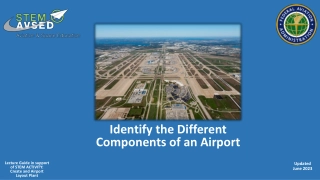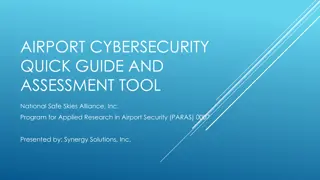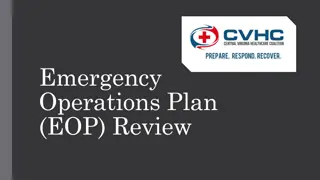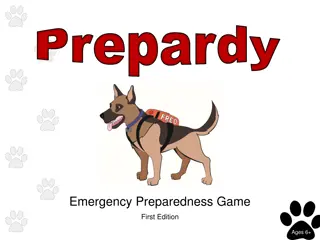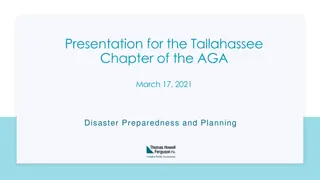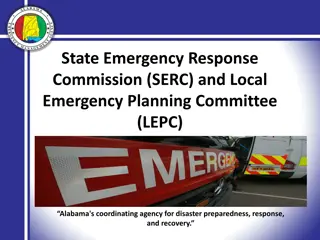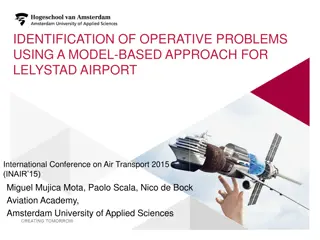Airport Emergency Preparedness: Essential Guidelines for Managers and Sponsors
Learn the critical aspects of Airport Emergency Plans (AEPs) to ensure the safety and preparedness of airports in the face of emergencies and incidents. Understand the purpose, development process, and key roles involved in AEPs. Discover the importance of differentiating between accidents and incidents in aviation operations and the significance of emergency preparedness in general aviation (GA) airport settings.
Download Presentation

Please find below an Image/Link to download the presentation.
The content on the website is provided AS IS for your information and personal use only. It may not be sold, licensed, or shared on other websites without obtaining consent from the author. Download presentation by click this link. If you encounter any issues during the download, it is possible that the publisher has removed the file from their server.
E N D
Presentation Transcript
Airport Emergency Plans (AEPs)
Purpose of This Course The purpose of this course is to help airport managers/sponsors learn: What is an AEP? Who is involved in an AEP Why every airport needs an AEP How to develop an AEP
Introduction Airports differ in complexity, but each has unique features. Some are small, uncomplicated facilities serving a more rural environment, while others represent a good- sized community complete with residential, industrial, and commercial installations serving major metropolitan areas. Airports are operated by the local government such as a city or county; or by an Authority representing multiple local governments; and some are operated by the State. However, one thing they all have in common is that they are all subject to emergencies and incidents. FAA AC 150/5200-31C
Introduction General aviation (GA) airports are typically found in smaller communities and have limited resources for staff, equipment, supplies, mutual aid resources, and training. Acknowledging this and compensating for it in emergency preparedness planning is imperative for providing essential services. Ultimately, it is the owner s responsibility to ensure that an airport is safe and well managed. Since most GA airports are publicly owned, that responsibility typically falls on the city, county, or airport authority. Generally, a full-time manager, contracted person, or public official with part-time airport management duties oversees the airport s daily operations. It is this person s job to prepare and use an emergency preparedness plan that ensures all involved parties are aware of their role in the plan. An annual assessment of the facilities and plan should identify limited resources so that a strategy can be implemented to meet as many shortfalls as possible.
What is an Airport Emergency? An airport emergency is any occasion or instance, natural or man-made that warrants action to save lives and protects property and public health. An airport incident can occur anywhere, at any time - day or night, under any weather condition, and in varying degrees of magnitude; it can occur instantaneously or develop slowly; it can last only a few minutes or go on for days. It can be natural, such as a hurricane or earthquake, or it can be man-made , such as a hazardous materials spill, civil unrest, terrorism, major fire, or power outage. Moreover, emergencies of the same type can differ widely in severity, depending on factors such as degree of warning, duration, and scope of impact. The important thing to remember is that, while emergencies can seldom be exactly predicted, they can be anticipated and prepared for.
Incident or Accidents? Accident An occurrence associated with the operation of an aircraft that: Results in death or serious injury Causes substantial damage to the aircraft Incident an occurrence other than an accident (no intention of flight) associated with the operation of an aircraft that affects or could affect the safety of operations. Why know the difference? Level of severity (High or Low Impact) An emergency plan can help your workers know how to respond to either of these situations
What is an Airport Emergency Plan? An airport emergency plan (AEP) is meant to support airports in defining roles and responsibilities of stakeholders during emergencies, identifying specific threats that could affect airports, and establishing communication protocols for the airport community. Airport emergency planning (AEP) is the process of preparing an airport to cope with an emergency occurring at the airport or in its vicinity. The object of airport emergency planning is to minimize the effects of an emergency. Particularly in respect of saving lives and maintaining aircraft operations.
Components Because an AEP must address many types of emergencies, it may be helpful to develop a basic plan that also covers the functions common to most emergency situations. This process involves conducting a careful airport hazard analysis that identifies all the common tasks that must be performed; assigning responsibility for accomplishing each function; and preparing standard operating procedures and checklists. FAA AC 150/5200-31C lists the components in this functional approach as: A. Basic Plan B. Functional Areas C. Hazard-Specific Sections D. Standard Operating Procedures (SOPs) and Checklists
Basic Plan The basic plan provides an overview of the airport s approach to emergency operations. It includes a general introduction section and addresses the organizations tasked within the plan and their basic roles and responsibilities. The sections of the plan and what they include are: Introduction Situation and Assumptions Organization and Assignment of Responsibility Administrative Review
Basic Plan : Introduction Revision date. Table of contents. Name of the legal authority for emergency operations and of who has approved the plan. Name of the emergency coordinator, such as the airport manager or emergency management officer, responsible for administration of the plan and review processes.
Basic Plan : Situation and Assumptions List of characteristics of the airport considered during preparation of the AEP and the airport hazard analysis. Discussion of the airport structure and factors that may affect response activities.
Basic Plan : Organization and assignment of responsibility List of each agency tasked within the AEP, by position and organizational responsibilities as well as tasks to be performed. Examples of individuals and agencies include: Airport manager Fire department Police department Health and medical services Communications officer Public information officer Air traffic control Airport maintenance Airport tenants Mutual aid agencies List of basic responsibilities in this section, including more detailed information to be found in functional areas and hazard-specific tabs.
Components: Functional Areas FAA AC 150/5200-31C lists the components in this functional approach as: A. Basic Plan B. Functional Areas C. Hazard-Specific Sections D. Standard Operating Procedures (SOPs) and Checklists
Functional Areas Functional areas are tasks and core responsibilities that may be applied to all airport emergencies. Detailed information particular to a specific emergency can be found in the standard operating procedures for hazard-specific areas, and FAA AC 150/5200-31C describes functional sections. Typical functional areas and their corresponding tasks are: Command and Control Communication Alert Notification and Warning Emergency Public Information Protective Actions Law Enforcement/Security Firefighting and Rescue Health and Medical Resource Management Airport Operations and Maintenance
Components: Hazard-Specific Sections FAA AC 150/5200-31C lists the components in this functional approach as: A. Basic Plan B. Functional Areas C. Hazard-Specific Sections D. Standard Operating Procedures (SOPs) and Checklists
Hazard-Specific Sections The hazard-specific section provides additional information regarding the response to a particular hazard or emergency situation. This detailed information is typically stand-alone and should be easily located within the AEP for quick reference. It may be helpful to provide tabs to quickly identify hazard- specific sections. In the AEP, hazard-specific emergencies include but are not limited to: Aircraft Accidents/Incidents Landside Emergencies Natural Disasters Fires Electrical Power Failures Hazardous Materials Wildlife Management Security/Criminal Activities
Components: Standard Operating Procedures (SOPs) and Checklists FAA AC 150/5200-31C lists the components in this functional approach as: A. Basic Plan B. Functional Areas C. Hazard-Specific Sections D. Standard Operating Procedures (SOPs) and Checklists
Standard Operating Procedures (SOPs) and Checklists Standard operating procedures (SOPs) and checklists provide detailed instructions that individuals or organizations tasked within the AEP may use to ensure all assigned responsibilities are being performed. They should be easily located within the AEP and should allow the user to provide detailed information useful later for insurance or investigation purposes, if needed.
Airport Emergency Plan Development Tools
Overview The online Airport Emergency Plan (AEP) Development Tool produces airport-specific AEPs in a format consistent with the Federal Aviation Administration s Advisory Circular 150/5200-31C titled, Airport Emergency Plan (AEP). The tool provides a user-friendly, sequential, and interactive format to create the plan, and includes introductory videos and question- specific help to enable accurate responses. The tool was developed under ACRP Projects 04-19 and 04-19A.
AEP Development Tool To use the development tool to create your AEP, click on the link provided and create a log in to access the tool Once an airport has created a log in, you will be taken to this login page to access your AEP Development page This website is free for all to use Airport Emergency Plan | Login (aepdevelopment.com)
Tips and Tools User must make a log in for their airport with a primary and secondary user. Once you submit your information, you will receive a confirmation email from support@aepdevelopme nt.com to finalize the registration of your airport. If you do not receive an email, please check your spam/junk email folder
AEP Development Tool Once logged in this is the home screen one will see. On the left-hand side is the topics and what questions have been completed, at the top is your navigation panel. Direction Icons Survey Progress and resume survey Question bank, green = answered yellow = unanswered
Direction Icons Resume Survey Preview Plans Admin Dashboard Training Videos Technical Support Log Out My Account * Found in the upper right- hand corner of window *
AEP Development Tool Topics that are covered within the AEP Development tool.
Airport Emergency Plan Development (Survey) Once you begin, on the top left you will be able to track your survey progress, see what questions you have answered, and will be able to resume where you left off in the survey.
AEP Survey Each question within the survey has three components to it. The green box is the question to be answered, the blue box is guidance on how to answer the question, and the orange box is reference to the Advisory Circular (AC) or the Code of Federal Regulation (CFR) that the question draws from.
AEP Survey Continued Question to be answered Put Answer to question here Save and move on to the next question Clear your answer Save your answer This section offers helpful tips on how to answer each question This section, if applicable for the question, provides the reference for the question to look up more information
Save and Continue Later If at any point you must end and come back to the survey later, you can save your question and log out. The program will remember were you left off and when you log back in, you click resume survey and it will take you back to the last place you left off on.
Generating Your Plan When you think you have completed developing your AEP, by clicking this icon in the upper right-hand corner, you will be able to preview the document you developed at any time. You will than be able to generate a PDF version of the plan from here.
Archived Plans The primary user can see all the plans that have been generated at any time. They can see who generated them, what version, when, and when it was last updated.
AEP Template from MN AirTAP The MnDOT and AirTAP Program has also come out with an airport emergency plan template that anyone can download and fill out with their airport s information. Link provided in the links slide.
Links Airport Emergency Plan | Login (aepdevelopment.com) Blank Emergency Guide by MnDOT emergency_guidebook.pdf (umn.edu) AC 150/5200-31C - Airport Emergency Plan (Consolidated AC includes Change 2) Document Information (faa.gov)





